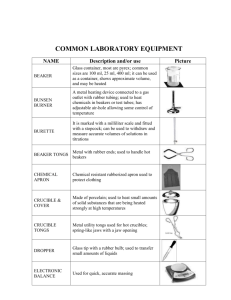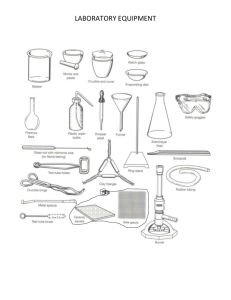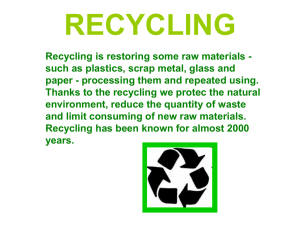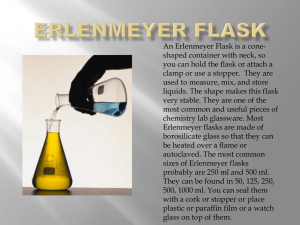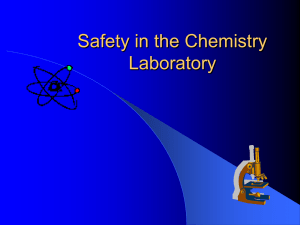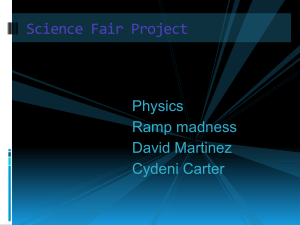Bunsen Burner
advertisement
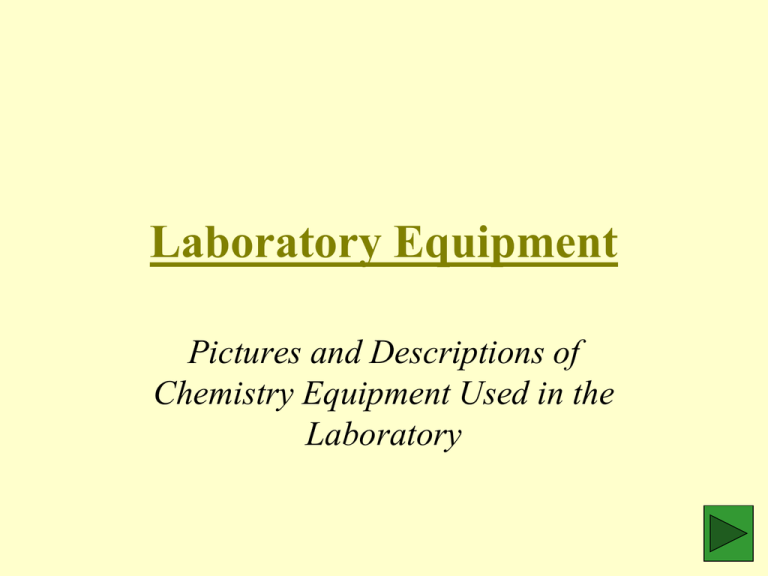
Laboratory Equipment Pictures and Descriptions of Chemistry Equipment Used in the Laboratory Beaker • Glass or plastic • Common sizes are 50 mL, 100 mL, 250 mL, 400 mL, 600 mL • Glass beakers can be heated, plastic cannot • Beakers are only used for measuring approximate volumes Beaker Tongs • Metal with plastic covering • Used to pick up hot beakers • Should not be held over a flame or the plastic will melt Bunsen Burner • Constructed of metal • Connected to a gas supply with rubber tubing • Used to heat chemicals in beakers, test tubes, and crucibles Clay Triangle • Wire frame with porcelain supports • It can be used to support a crucible if it is placed on a iron ring Crucible & Cover • Porcelain • Used to heat small amounts of solid substances at high temperatures Crucible Tongs • Iron or Nickel • Used to pick up and hold small items (such as crucibles and their lids) Dropper Pipet • Glass tip with rubber bulb • Used to transfer small volumes of liquid Electronic Balance • Used for measuring the mass of chemicals and objects less than 400 grams • Chemicals and hot glassware should never be placed directly on the balance Erlenmeyer Flask • Glass • Common sizes are 50 mL, 125 mL and 250 mL • May be heated • Can be used as a reaction vessel such as in a titration Evaporating Dish • Porcelain • Used to contain small volumes of liquid being evaporated Flint Striker • Metal with magnesium flint • Used to light a Bunsen burner Forceps • Metal • Used to hold or pick up small objects Four Beam Balance • Used for measuring the mass of chemicals and small objects • Usually a four beam balance can more accurately find masses than a three beam (platform) balance Funnel • Glass or plastic • Common size holds 12.5 cm diameter filter paper • Can be used for separating mixtures Graduated Cylinder • Glass or plastic • Common sizes are 10 mL, 50 mL, and 100 mL • Used to measure the volume of a liquid • Must not be heated and reactions should not be done in the graduated cylinder Grease or Wax Pencil • Wax marking pencil • Used to write on glassware Mortar and Pestle • Porcelain • May be used to grind crystals and lumpy chemicals to a powder Nichrome Wire • Glass or metal rod with a nichrome wire attached • Used for conducting flame tests Petri Dish & Cover • Glass top and bottom • Used for examining specimens Platform Balance • Sometimes also referred to as a triple beam balance • Used for measuring the mass of chemicals and small objects Policeman • Plastic • Used to remove precipitates from glassware Ring Clamp • Metal • Can be attached to a ring stand to support beakers or other glassware Ring Stand • Metal rod fixed upright in a heavy metal base • Has many uses as a support Safety Goggles • Plastic • Must be worn at all times while working in the laboratory Scoopula or Microspatula • Metal • Used to transfer solid chemicals • The scoopula has a larger capacity Stirring Rod • Glass rod • Used to stir and assist in pouring liquids Test Tubes • Glass • Common sizes : small (13 mm x 100 mm) medium (20 mm x 150 mm) large (25 mm x 200 mm) • May be heated • Should not be used if chipped or cracked Test Tube Brush • Bristles with wire handle • Used to scrub small diameter glassware (like test tubes) Test Tube Clamp • Metal • Can be attached to a ring stand to hold small diameter glassware Test Tube Holder • Spring metal • Used to hold test tubes or glass tubing Test Tube Rack • Wood or plastic • Holds test tubes in a vertical position Triangular File • Metal • Used to scratch glass tubing prior to breaking to desired length Wash Bottle • Flexible plastic • Should only be filled with distilled water • Used to rinse chemicals from glassware Watch Glass • Glass • Used to cover an evaporating dish or beaker Wire Gauze • Metal with asbestos center • Used to spread the heat of a Bunsen burner Utility Tongs • Metal • Used for picking up hot objects
